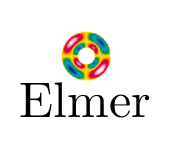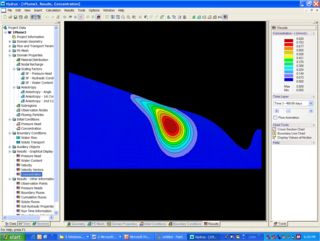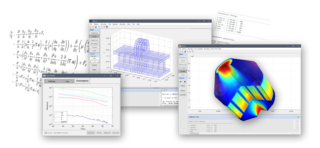
Hydrogeology is the area of geology that deals with the distribution and movement of groundwater in the soil and rocks of the Earth's crust. The terms groundwater hydrology, geohydrology, and hydrogeology are often used interchangeably.

Elmer is computational tool for multi-physics problems. It has been developed by CSC in collaboration with Finnish universities, research laboratories and industry. Elmer FEM solver is free and open-source software, subject to the requirements of the GNU General Public License (GPL), version 2 or any later.
The United States Environmental Protection Agency (EPA) Storm Water Management Model is a dynamic rainfall–runoff–subsurface runoff simulation model used for single-event to long-term (continuous) simulation of the surface/subsurface hydrology quantity and quality from primarily urban/suburban areas. It can simulate the Rainfall- runoff, runoff, evaporation, infiltration and groundwater connection for roots, streets, grassed areas, rain gardens and ditches and pipes, for example. The hydrology component of SWMM operates on a collection of subcatchment areas divided into impervious and pervious areas with and without depression storage to predict runoff and pollutant loads from precipitation, evaporation and infiltration losses from each of the subcatchment. Besides, low impact development (LID) and best management practice areas on the subcatchment can be modeled to reduce the impervious and pervious runoff. The routing or hydraulics section of SWMM transports this water and possible associated water quality constituents through a system of closed pipes, open channels, storage/treatment devices, ponds, storages, pumps, orifices, weirs, outlets, outfalls and other regulators. SWMM tracks the quantity and quality of the flow generated within each subcatchment, and the flow rate, flow depth, and quality of water in each pipe and channel during a simulation period composed of multiple fixed or variable time steps. The water quality constituents such as water quality constituents can be simulated from buildup on the subcatchments through washoff to a hydraulic network with optional first order decay and linked pollutant removal, best management practice and low-impact development removal and treatment can be simulated at selected storage nodes. SWMM is one of the hydrology transport models which the EPA and other agencies have applied widely throughout North America and through consultants and universities throughout the world. The latest update notes and new features can be found on the EPA website in the download section. Recently added in November 2015 were the EPA SWMM 5.1 Hydrology Manual and in 2016 the EPA SWMM 5.1 Hydraulic Manual and EPA SWMM 5.1 Water Quality Volume (III) + Errata”
Groundwater models are computer models of groundwater flow systems, and are used by hydrogeologists. Groundwater models are used to simulate and predict aquifer conditions.
FEFLOW is a computer program for simulating groundwater flow, mass transfer and heat transfer in porous media and fractured media. The program uses finite element analysis to solve the groundwater flow equation of both saturated and unsaturated conditions as well as mass and heat transport, including fluid density effects and chemical kinetics for multi-component reaction systems.

HydroGeoSphere (HGS) is a 3D control-volume finite element groundwater model, and is based on a rigorous conceptualization of the hydrologic system consisting of surface and subsurface flow regimes. The model is designed to take into account all key components of the hydrologic cycle. For each time step, the model solves surface and subsurface flow, solute and energy transport equations simultaneously, and provides a complete water and solute balance.
SEEP2D is a 2D seepage analysis program written by Dr. Fred Tracy of the United States Army Corps of Engineers. The program is used to analyze water seepage, typically through dams and levees or under sheet piles. "The model is internationally known in the engineering community as a model for complicated seepage analysis of dams and levees." It has been shown to have acceptable accuracy compared with experimental results.

OpenFOAM is a C++ toolbox for the development of customized numerical solvers, and pre-/post-processing utilities for the solution of continuum mechanics problems, most prominently including computational fluid dynamics (CFD).
Femap is an engineering analysis program sold by Siemens PLM Software that is used to build finite element models of complex engineering problems ("pre-processing") and view solution results ("post-processing"). It runs on Microsoft Windows and provides CAD import, modeling and meshing tools to create a finite element model, as well as postprocessing functionality that allows mechanical engineers to interpret analysis results. The finite element method allows engineers to virtually model components, assemblies, or systems to determine behavior under a given set of boundary conditions, and is typically used in the design process to reduce costly prototyping and testing, evaluate differing designs and materials, and for structural optimization to reduce weight.

Hydrus is a suite of Windows-based modeling software that can be used for analysis of water flow, heat and solute transport in variably saturated porous media. HYDRUS suite of software is supported by an interactive graphics-based interface for data-preprocessing, discretization of the soil profile, and graphic presentation of the results. While HYDRUS-1D simulates water flow, solute and heat transport in one-dimension, and is a public domain software, HYDRUS 2D/3D extends the simulation capabilities to the second and third dimensions, and is distributed commercially.

The FEniCS Project is a collection of free and open-source software components with the common goal to enable automated solution of differential equations. The components provide scientific computing tools for working with computational meshes, finite-element variational formulations of ordinary and partial differential equations, and numerical linear algebra.
Z88 is a software package for the finite element method (FEM) and topology optimization. A team led by Frank Rieg at the University of Bayreuth started development in 1985 and now the software is used by several universities, as well as small and medium-sized enterprises. Z88 is capable of calculating two and three dimensional element types with a linear approach. The software package contains several solvers and two post-processors and is available for Microsoft Windows, Mac OS X and Unix/Linux computers in 32-bit and 64-bit versions. Benchmark tests conducted in 2007 showed a performance on par with commercial software.
SVSLOPE is a slope stability analysis program developed by SoilVision Systems Ltd.. The software is designed to analyze slopes using both the classic "method of slices" as well as newer stress-based methods. The program is used in the field of civil engineering to analyze levees, earth dams, natural slopes, tailings dams, heap leach piles, waste rock piles, and anywhere there is concern for mass wasting. SVSLOPE finds the factor of safety or the probability of failure for the slope. The software makes use of advanced searching methods to determine the critical failure surface.
FEBio(Finite Elements for Biomechanics) is a software package for finite element analysis and was specifically designed for applications in biomechanics and bioengineering. It was developed in collaboration with research groups from the University of Utah and Columbia University (MBL).
ADINA is a commercial engineering simulation software program that is developed and distributed worldwide by ADINA R & D, Inc. The company was founded in 1986 by Dr. Klaus-Jürgen Bathe, and is headquartered in Watertown, Massachusetts, United States.

VisualFEA is a finite element analysis program running on MS Windows and Mac OS X platforms. The program is being developed and distributed by Intuition Software, Inc. in South Korea, and is used chiefly for structural and geotechnical analysis. The strongest point of the program is its intuitive and user-friendly usage based on graphical pre- and postprocessing capabilities. VisualFEA has educational functions for teaching and learning structural mechanics and finite element analysis through graphical simulation. Thus, this program is widely used in college courses related to structural mechanics and finite element method.

DIANA is a Finite Element Analysis (FEA) solver developed and distributed by DIANA FEA BV and several other resellers worldwide. The software is utilised at both ends of the market, by small consultancies and global engineering consultants, research institutions and is utilised by many highly respected educational institutions worldwide in both civil and geotechnical engineering courses. DIANA is equipped with very powerful solvers which enables the analysis of a wide range of structures, large and small - with basic or advanced analyses. A large selection of material models, element libraries and analysis procedures are available within the package which gives DIANA a large degree of flexibility. The main fields of use of DIANA include design and analysis of dams & dikes; tunnels & underground structures; oil & gas & historical constructions and large reinforced concrete structures. Some of the specialised analyses available in DIANA for these fields of use include seismic analysis; fire analysis and young hardening concrete.

GetFEM++ is a generic finite element C++ library with interfaces for Python, Matlab and Scilab. It aims at providing finite element methods and elementary matrix computations for solving linear and non-linear problems numerically. Its flexibility in choosing among different finite element approximations and numerical integration methods is one of its distinguishing characteristics.

FEATool Multiphysics is a physics, finite element analysis (FEA), and PDE simulation toolbox. FEATool Multiphysics features the ability to model fully coupled heat transfer, fluid dynamics, chemical engineering, structural mechanics, fluid-structure interaction (FSI), electromagnetics, as well as user-defined and custom PDE problems in 1D, 2D (axisymmetry), or 3D, all within a simple graphical user interface (GUI) or optionally as convenient script files. Having specifically been designed to have a low learning curve and to be able to be used without requiring reading documentation, FEATool has been employed and used in academic research, teaching, and industrial engineering simulation contexts.









